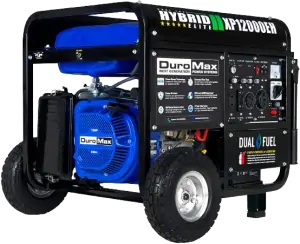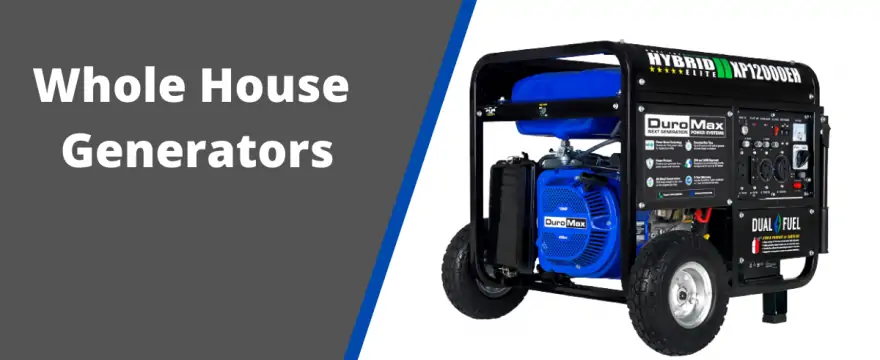A reliable backup power supply for the best generator for the home is now more important than ever. Best Whole House Generators Consumer Reports DuroMax XP12000EH most recommended whole house generator for consumers.
After more than 24 hours of research, we have selected which of these 10 products is most recommended for you. We offer portable and standby generators that all have just enough power to supply your entire household.
A blackout may occur at any time, and you can use all your essential items, such as refrigerators, freezers, AC, lights, and other essential items. An automatic backup generator can be very useful if you live in a part of the country where blackouts are frequent and go on for hours. Best Whole House Generators Consumer Reports GUIED be helpful in these cases because many situations leave the public without power.
The loss of electricity can harm our daily lives. We cannot use the internet, eat, or do a number of other daily functions. This can be dangerous. Therefore, the best whole-house generators are designed to deliver enough power to run the entire home.
This post discusses everything about the Best Whole House Generators. A comprehensive collection of reviews, buying guides, and comparison tables of the best whole-house generators.
Best Whole House Generator Reviews – Top Choice
DuroMax XP12000EH or Duramax xp13000eh vs xp12000eh.It has the ability to generate power of up to 10,000 watts by using propylene or 9,000 watts by using natural gas. The regulator automatically adjusts power to give the best performance.
It comes with a 5-year limited warranty. And, with a power management system, you can run multiple devices simultaneously without overloading them. The product also features a power output regulator.

Within seconds of activating and switching the fuel source, a whole house can be fully powered. It also has an automatic transfer switch, service entrance rated.
The Vanguard engine is in-house and reliable. It is designed, in part, for high-performance commercial applications. Optimizing power distribution and allowing long periods of operation, while boasting a quiet muffler system with unique airflow and sound-dampening technology. This is the best home generator.
Consumer Reports (CR) evaluates home standby generators using a combination of laboratory and real-world testing to determine their performance, reliability, and ease of use.
CR tests in evaluating home standby generators:
- Power Output: CR tests the maximum output of each generator and assesses its ability to maintain a steady power supply over time.
- Noise Level: CR measures the noise level of each generator and evaluates how it compares to similar models. They also test the noise level from inside the house and assess how loud it sounds.
- Fuel Efficiency: CR tests the fuel efficiency of each generator by measuring how much fuel it consumes per hour of operation.
- Automatic Transfer Switch (ATS): CR evaluates the ATS system of each generator and assesses how quickly it can detect a power outage and switch to generator power.
- Ease of Use: CR assesses how easy it is to start and operate each generator, how clear the controls and indicators are, and how easy it is to access the fuel and oil fillers.
General tips for using and maintaining a generator:
- Read the owner’s manual: Before operating your generator, read the owner’s manual carefully to ensure that you understand how to use it safely and effectively.
- Choose the right location: Place the generator in a well-ventilated, dry location that is away from doors, windows, and vents. Do not use it indoors or in an enclosed space.
- Fuel properly: Use the recommended type of fuel and fill the tank before starting the generator. Store fuel in a cool, dry, and ventilated area, and avoid spilling fuel while filling the tank.
- Maintain the generator: Regularly check and replace the oil and air filter, and keep the generator clean and dry. Check the spark plug and battery if applicable, and replace them if needed.
- Start the generator properly: Follow the start-up procedure in the owner’s manual, and do not overload the generator. Allow the generator to run for a few minutes before connecting any devices to it.
- Use appropriate extension cords: Use heavy-duty, outdoor-rated extension cords that are grounded and have a wattage rating that can handle the load of your devices.
- Turn off the generator properly: Turn off and unplug all devices connected to the generator before turning it off. Let the generator run for a few minutes to cool down, and then turn it off and unplug it.
- Store the generator properly: Store the generator in a dry and secure location, and protect it from dust, moisture, and pests. Drain the fuel from the tank and carburetor if storing it for an extended period.
Following these tips can help you use and maintain your generator safely and effectively, and extend its lifespan.
Overall, Consumer Reports uses a rigorous testing process to evaluate home standby generators and provide unbiased and reliable information to consumers.
Features that you should take into consideration:
Power Output: The power output of the generator should be sufficient to power all of the appliances and devices in your home. Look for a model with a wattage rating that matches or exceeds your total power needs.
Fuel Type: Whole house generators are typically powered by natural gas, propane, or diesel fuel. Consider which type of fuel is most readily available in your area, and choose a model that uses that fuel.
Automatic Transfer Switch (ATS): An ATS is a device that automatically switches the power source from the utility grid to the generator when it detects a power outage. Look for a generator with a reliable and efficient ATS system.
Noise Level: Whole house generators can be noisy, so consider a model with a low noise level that meets your needs.
Maintenance: Look for a generator that is easy to maintain, with accessible parts and filters. Some models also offer remote monitoring and diagnostics for easy maintenance.
Size and Portability: Whole house generators can be large and heavy, so consider the size and portability of the model you are considering. Some models are designed for permanent installation, while others can be moved as needed.
Safety Features: Look for a generator with safety features such as automatic shutdown in case of low oil or overloading, and built-in surge protection.
Considering these features can help you choose the best whole house generator for your needs, providing you with reliable backup power in case of an outage. It is also important to read reviews and ratings from other consumers, and to consult with a licensed electrician before making a final decision.
Yes, You Need a Transfer Switch:
If you have a standby generator that is designed to power your home during an outage, you should install a transfer switch to ensure safe and efficient operation. A transfer switch is a device that connects your home’s electrical system to the generator, and it is designed to automatically switch the power source from the utility grid to the generator in case of an outage. Here are some reasons why a transfer switch is necessary:
- Safety: A transfer switch prevents backfeeding, which is the flow of electricity back through the power lines to the utility grid. Backfeeding can be dangerous to utility workers and can damage electrical equipment. A transfer switch ensures that the generator’s power is used only in your home and not transmitted back to the grid.
- Efficiency: A transfer switch ensures that the generator’s power is distributed efficiently to the circuits in your home that you have designated to be powered during an outage. Without a transfer switch, you would have to manually disconnect the circuits that you don’t want to power, which can be time-consuming and unsafe.
- Convenience: A transfer switch is designed to automatically switch the power source to the generator, which means you don’t have to manually start and stop the generator or switch the power source between the utility grid and the generator.
- Compliance: In most jurisdictions, it is required by law to install a transfer switch for standby generators. This ensures that the installation meets electrical codes and safety standards.
Overall, installing a transfer switch is an essential part of a safe and reliable standby generator installation. It is important to consult with a licensed electrician to ensure that the transfer switch is installed properly and meets all applicable codes and standards.
- The power management functions of Symphony II can take care of much of the load while keeping the smaller load requirements in a manageable range.
- This voltage regulator maintains optimum digital voltage and frequency regulation with low harmonic distortion, allowing advanced electronic devices to operate reliably even in unstable power.
- A stylish Designed with a stylish and corrosion-resistant enclosure.
- A power module is missing from the transfer switch. It will need to be purchased separately. Make sure you check if anything is missing before installation.
- The internal components of the housing are not accessed easily.
- List of 10 Best Generators for RV
- List of Top 6 Best Portable Inverter Generators
- List of Best Quiet Generator
- List of 10 Best Generators with Inverter
- List of Best Dual Fuel Generator
- List of Best Solar Generators
- List of 6 Best Inverter Generator
- List of 6 Best Camping Generators
- List of 6 best whole house generator

Leave a Reply